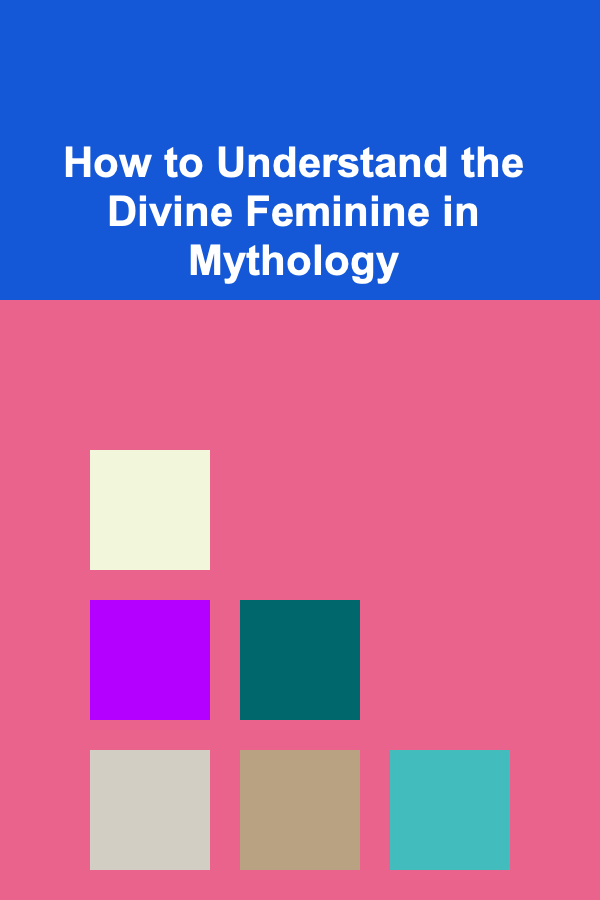
How to Understand the Divine Feminine in Mythology
ebook include PDF & Audio bundle (Micro Guide)
$12.99$10.99
Limited Time Offer! Order within the next:

The concept of the divine feminine is a profound and essential aspect of mythologies around the world. This concept embodies a multitude of qualities, including fertility, wisdom, creativity, nurturing, and destruction. Across various cultures and religions, the divine feminine is represented in different forms, each reflecting the societal values, beliefs, and spiritual practices of the people who created them. Understanding the divine feminine in mythology involves not only analyzing the roles of goddesses and female figures but also delving into their symbolic meanings and their impact on human understanding of balance, power, and the forces of nature.
In this article, we will explore the divine feminine in mythology by examining the archetypes, representations, and lessons offered by mythological stories. By understanding these myths, we can gain insights into how ancient cultures viewed femininity, the sacred, and the feminine principle's role in the cosmos.
The Archetype of the Divine Feminine
The archetype of the divine feminine is not confined to one specific image but rather represents a range of roles that goddesses and female figures embody. The divine feminine is often seen as an archetype of power and grace, a cosmic force that governs the cycles of life, death, and rebirth. She is a symbol of the natural world's rhythm and the cyclical patterns of time. To understand her in mythology, we must first look at some of the common archetypes associated with the divine feminine.
The Mother Archetype
One of the most prominent representations of the divine feminine is the archetype of the Mother. The mother figure is central to numerous mythologies, often symbolizing fertility, creation, and life itself. The mother is nurturing and protective, associated with both the birth and the sustenance of life. This archetype is prevalent in many cultures, from the Greek goddess Demeter, the Roman Ceres, and the Hindu goddess Parvati, to the Egyptian goddess Isis.
In these mythologies, the mother often has a dual role: she is the giver of life but also the protector and defender of her offspring. She is not just a passive figure but a powerful, active force that shapes the world. The mother archetype teaches about the deep connection between creation and destruction, life and death. It is within her that these cycles of existence are held, and through her that all beings experience their own growth and transformation.
The Warrior Archetype
While the divine feminine is often associated with nurturing and creativity, she also takes on the warrior archetype, representing strength, courage, and independence. This aspect of the divine feminine is seen in mythological figures such as Athena, the Greek goddess of wisdom and war; Kali, the Hindu goddess of destruction and rebirth; and the Norse Valkyries, fierce female warriors who choose the slain in battle.
These warrior goddesses often embody the fierce, unyielding spirit of the feminine, demonstrating that femininity is not just about passivity or softness but also about taking action and wielding power. The warrior archetype challenges traditional gender roles and invites a broader understanding of the feminine as dynamic, powerful, and transformative.
The Wise Woman Archetype
In many mythologies, the divine feminine is also symbolized by the archetype of the wise woman. She is a figure of knowledge, intuition, and spiritual guidance. Often depicted as an old woman or a crone, she represents the accumulated wisdom of a lifetime and the deep, intuitive understanding of the world's mysteries. Examples of this archetype can be seen in figures like the Greek goddess Hecate, the Celtic Morrigan, and the Slavic Baba Yaga.
The wise woman is often portrayed as a solitary figure who has the power to transform and heal. Her wisdom is not derived from formal learning but from an intuitive, mystical connection with the universe. Through her, we learn about the importance of introspection, self-awareness, and connection to the hidden realms of knowledge and truth.
The Lover Archetype
Another crucial representation of the divine feminine is the lover archetype, associated with beauty, passion, and emotional connection. The lover embodies attraction, desire, and the sacred union of opposites. In mythology, the lover can be found in goddesses such as Aphrodite (Venus), the Greek goddess of love and beauty; Freyja, the Norse goddess of love and fertility; and Lakshmi, the Hindu goddess of wealth and beauty.
These goddesses represent the powerful, transformative force of love, both in terms of romantic passion and spiritual devotion. The lover archetype teaches about the profound impact that love and beauty have on the human experience. Through love, the divine feminine demonstrates that connection, unity, and attraction are powerful forces that can bring about change and transformation.
The Creator Archetype
In addition to her roles as mother, warrior, wise woman, and lover, the divine feminine is often seen as a creator and originator of life. In many cultures, the goddess is the source of the cosmos and the one who brings order to chaos. Examples of creator goddesses include Gaia, the Greek personification of Earth; Hathor, the Egyptian goddess of love and motherhood; and Shakti, the Hindu divine energy that is believed to have created the universe.
These creator goddesses are central to understanding the divine feminine as the source of all that is. They represent the generative force of the universe, responsible for the creation and maintenance of all things. Through them, we learn that creativity is a fundamental aspect of the divine feminine, not just in terms of the physical world but also in the realm of ideas, culture, and spiritual energy.
The Divine Feminine and the Cycles of Nature
One of the most essential aspects of the divine feminine is her deep connection to the natural world and the cycles of nature. In many mythologies, goddesses are associated with natural phenomena such as the moon, the earth, the seasons, and the harvest. This connection highlights the cyclical nature of life and the importance of balance between the forces of creation and destruction, life and death.
The Moon and the Divine Feminine
The moon is perhaps the most potent symbol of the divine feminine in mythology. In many cultures, the moon is seen as a feminine force, associated with intuition, emotion, and the unconscious. The phases of the moon mirror the cycles of a woman's life, from menstruation to menopause, and represent the ever-changing nature of existence.
Goddesses such as Artemis (Greek), Selene (Greek), and Chandra (Hindu) are lunar deities who embody the moon's cycles. These goddesses are often depicted as guardians of the night and are associated with fertility, intuition, and emotional depth. They teach us to embrace change, to honor the ebb and flow of our own lives, and to find power in stillness and reflection.
The Earth and the Divine Feminine
In many mythologies, the Earth is personified as a goddess, often referred to as Mother Earth or the Earth Mother. The Earth is seen as the source of all life, nurturing and sustaining humanity and all other living beings. Goddesses like Gaia (Greek), Pachamama (Inca), and Demeter (Greek) represent the Earth's fertile, nurturing aspect.
These goddesses are closely tied to agricultural cycles and the rhythms of nature, embodying the cycles of planting, growth, and harvest. Their stories teach about the importance of sustainability, the need to honor and care for the Earth, and the deep, interconnected relationship between humanity and the natural world.
The Seasons and the Divine Feminine
Many mythologies also feature goddesses who represent the changing seasons, particularly the cycle of death and rebirth. The story of Persephone, the Greek goddess of spring, is a prime example. Persephone's journey to the underworld, where she is held captive by Hades, symbolizes the descent into darkness, while her return marks the arrival of spring and the renewal of life. This cycle represents the constant interplay between life and death, destruction and creation.
In other traditions, the changing of the seasons is seen as a reflection of the divine feminine's power to bring about transformation. Through the divine feminine, we understand that everything is in a state of flux and that each ending gives rise to a new beginning.
The Divine Feminine and Balance
A critical lesson in understanding the divine feminine is the recognition of balance. In many mythologies, the feminine principle is not seen as opposing the masculine but as complementary to it. The divine feminine embodies qualities that balance out the often aggressive and destructive forces of the masculine. Through her, we learn that true power comes from harmony, not domination.
The divine feminine represents the nurturing, intuitive, and creative forces of the universe, which work in tandem with the assertive, logical, and structured forces of the masculine. By understanding the interplay between these two forces, we can achieve a deeper understanding of ourselves and the world around us.
Conclusion
The divine feminine in mythology is a powerful and multifaceted concept that offers profound insights into the human experience. From the nurturing mother to the fierce warrior, the wise woman to the passionate lover, the divine feminine embodies a wide range of qualities that are essential for personal and spiritual growth. Through her, we understand the cycles of nature, the interconnectedness of all life, and the importance of balance in the cosmos.
By exploring the divine feminine in mythology, we not only gain a deeper appreciation for the goddesses and female figures of ancient cultures but also learn important lessons about the nature of femininity, power, and transformation. The divine feminine continues to inspire and guide us, helping us connect with the sacred and find our place within the grand tapestry of existence.

Gear Up for Excellence: Tools, Equipment, and Best Practices for Maintenance Technicians
Read More
How to Plan a Seasonal Celebration at Home
Read More
Top Tips for Shopping Smart During Sale Seasons and Scoring Big Discounts
Read More
How To Play the Bagpipes: Learning the Chanter
Read More
How to Market Yourself as a Stage Actor
Read More
How to Decorate a Cake with Isomalt Decorations
Read MoreOther Products

Gear Up for Excellence: Tools, Equipment, and Best Practices for Maintenance Technicians
Read More
How to Plan a Seasonal Celebration at Home
Read More
Top Tips for Shopping Smart During Sale Seasons and Scoring Big Discounts
Read More
How To Play the Bagpipes: Learning the Chanter
Read More
How to Market Yourself as a Stage Actor
Read More